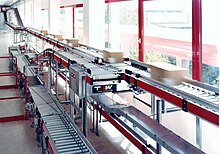Conveyor technology

The conveyor technology (FT) ( English material handling ) is a branch of engineering that deals with the design, the design, planning and execution of funding for conveying of cargo (pallets, crates, packages, individual workpieces etc.) or bulk ( Sand , ore , grain, etc.). The transport of liquid media and gases with pipelines is usually not part of conveyor technology, but part of plant construction .
Conveyor technology is initially understood to mean the actual technology ("conveying means" such as cranes , belt conveyors , forklifts ), but also the process design when operating the systems. The conveyor technology specialist area therefore includes the entirety of all transport , transshipment and storage tasks or processes, both in technical and economic terms. This area is often summarized under the term logistics .
In contrast to traffic technology , which deals with long-range transport, conveyor technology deals with the movement of goods in defined operational areas such as ports, airports, in mining or in industrial plants.
Conveyor components are ropes and pulleys, rope pulleys, rope drums and traction sheaves . Round steel chains , articulated chains , chain wheels and chain drums are required for chain drives. Conveyor belts are the main component of conveyor belts . Chassis elements are wheels and rails. As load handling devices are called load hook, hook harnesses, shackles, pliers and clamps, buckets and grapple. Other components of conveyor technology are engines and brakes .
The in-house transport systems are also included in the conveyor technology. These include continuous conveyor as roller conveyors , feeders , belt bucket elevators and belt conveyors and discontinuous conveyors as man-operated industrial trucks (forklift trucks, platform trucks, etc.), cranes , automated truck loading systems , Automated Guided Vehicles (AGV), workpiece conveyor and vertical conveyor as lifting tables or Belt lifter. Internal transport systems primarily have the task of transporting goods from the point of delivery to the point of delivery as efficiently as possible.
In the factory automation play pneumatic drives, for example for conveying semi-finished and finished products, a significant role. The pneumatic conveying system of the pneumatic tube is rarely used today.
See also
literature
- Rudolf Griemert, Peter Römsch: Conveyor technology - selection and calculation of elements and assemblies , Springer, 11th edition, 2015.
- Alfred Böge (Ed.): Handbuch Maschinenbau , Springer, 21st edition, 2013, (Chapter "K: Conveyor technology").
- Dubbel: Taschenbuch für den Maschinenbau, Berlin: Springer-Verlag 1990
- DIN: Taschenbuch 44, Fördertechnik 1, Berlin: Beuth-Verlag 1995
- DIN: Taschenbuch 185, Fördertechnik 2, Berlin: Beuth-Verlag 1995
- DIN: Taschenbuch 187, Fördertechnik 3, Berlin: Beuth-Verlag 1995
Individual evidence
- ↑ IPH - Internal transport: conveyor technology, continuous conveyors and discontinuous conveyors. Retrieved January 27, 2018 .
